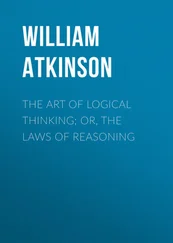One adds very materially to his fund of information, and to his pleasure by cultivating the art of perception. In traveling, for instance, many persons miss much of the best scenery— many objects of the greatest interest—by failing to perceive them. They return and read works of travel describing the same location, and are astonished at the wealth of description while they saw so little. And many miss the best parts of a book, by reason of careless reading.
The Indian and the backwoodsman will notice the broken twig, the turned leaf, the footprint, where the untrained observer sees nothing uncommon.
We remember reading somewhere of a merchant who was laughed at for having an ignorant man in his employ as buyer. He replied that it was true that the employee spelled worse than Josh Billings—that his grammar was enough to make Lindley Murray turn over in his grave—that he had never read the works of a standard author—but he knew how to see things—he bought thousands of dollars’ worth of goods every year for the merchant and had never been known to make a mistake, or to fail to note a defect, or any objectionable feature in the goods. This man had cultivated the faculty of perception, and was turning it to account.
Very few of us notice the details of the most common objects. How many of you know whether a cow’s ears are above, below, behind or in front of her horns? How many can tell whether a cat descends from a tree head or tail first. How many know whether cows and horses rise with their fore or hind feet first, or whether both animals have the same habit of rising? How many know how the number “four” appears on a watch dial?— most of you will say iv—look at your watch.
The eminent scientist Agassiz had a wonderful success in training his pupils to observe. The highly trained powers of perception which he developed in them undoubtedly contributed largely to the success of the large number of his pupils who made names and places for themselves in after years. It is related of him that one day a favorite pupil asked for additional training along these lines. Agassiz handed him a jar containing a fish, and told him to carefully examine it and report to him later what he had noticed about the fish. The pupil had seen the same kind of fish before, and could not understand why the professor had given him so trifling a task. He looked at the specimen but saw nothing of interest. He was unable to find the professor, and was compelled to remain with the tiresome fish for several hours, much to his disgust. After a bit, to relieve the monotony, he took the fish out of the jar and began to draw its figure. This was easy enough until he began to fill in the details. Then he made the interesting discovery that the fish had no eyelids, also several little points of interest that were new to him.
When Agassiz returned he seemed disappointed that the student had found out so little about the fish, and told him to try for a few hours more. The student, finding that there was no escape, started to work in earnest, bearing in mind Agassiz’s remark that “a pencil is the best of eyes.” He began to see more and more of interest in that fish, and grew quite interested in the task. The professor would come in from time to time, and hear of the student’s new discoveries, but would say little or nothing. He kept the student at work on that same fish for three long days, and the student wondered greatly that he had been able to see so little before, where there was so much to be seen and noted. The student, many years after, had made a name for himself, and was wont to tell this story, with the observation that the lesson gained by the study of that fish had extended to the details of every subsequent study, and that the experience thus gained was of inestimable value to him. It is said of Agassiz that he could deliver a popular lecture on an insect like the grasshopper, and make it so interesting that the audience became as intent as if they were witnessing a play.
In London there are said to be places where young thieves are instructed in the art of rapid and close observation. The “professor” instructing young rascals will place in his hand a number of small objects, such as a key, a button, a coin, a ring, etc. He will open his hand an instant before his class, who are required not only to name the objects seen but to describe them. Then changes will be made in the object and the boys must detect the article substituted at once. These students, after a course of training, are sent out as beggars. They endeavor to catch a glimpse into offices, rooms, houses, etc., and to note any article of value within range of their sight, its location, the doors, locks, etc., etc. They report to headquarters and if the prospects are good a burglary is forthcoming.
The above will be seen to resemble the method used to train “Kim,” as related in a preceding chapter. Readers of Conan Doyle’s fascinating “Sherlock Holmes” tales will remember the wonderful powers of perception possessed by that amateur detective, and the results accomplished because of same. Gamblers are close observers, and can often tell the hand held by their opponent, by the expression of his face, although the opponent may not be aware of betraying himself.
The Italians have a game called Morra, which is a great favorite among their boys, and which when played regularly makes the little chaps as observant as foxes. It is played by two boys, and consists in both throwing out any number of fingers simultaneously, each player crying out as rapidly as he can the number of fingers shown by the other. We have noticed a variation of this game, played by the Italian newsboys in Chicago, while waiting for their papers. One will wait until he has the attention of the other boy, and then will suddenly throw out his fist with one or more fingers displayed, shouting “Morra.” The other boy must name the number of fingers immediately, else he will receive over the head a sound whack from a rolled up newspaper in the hand of the other boy. Coture, the great teacher of drawing, instructed his pupils to let their eyes rest for a moment on passersby in the street, and then attempt to draw them. The plan met with perfect success, after practice. At first only a hat, or an arm or a leg would be distinctly registered, but in a short time the entire figure in all its details was recorded. In the School of Design in St. Petersburg, Russia, the pupils are instructed to study an object for ten minutes, and then, the object being withdrawn, they proceed to draw it. Varney, the celebrated teacher, would place the object to be drawn in one room, and have his pupils at work in another room, allowing them to go from time to time to take a look at the object.
Garbielli, a French artist, painted a most expressive portrait of James Gordon Bennett, whom he had only seen once as he went by rapidly in a carriage. One of the most speaking pictures of Lincoln we have ever seen was painted by a talented but practically unknown artist in New Jersey, who was a most ardent admirer of the great President, whom he had seen but once. The artist was so overcome with emotion at hearing of the assassination of his idol that he sought his easel for solace, and reproduced the murdered President’s features entirely from memory. Many years ago, about 1845, the old Academy of Fine Arts in Philadelphia, was destroyed by fire, and among other valuable paintings there perished a picture by Murillo, entitled “The Roman Daughter.” Nearly thirtyfive years afterwards, Sartain drew the picture from memory. In 1805 the French troops carried away a masterpiece of Rubens, which had formed the altarpiece in the Church of St. Peter, in Cologne. A local painter, a great admirer of the picture, made from memory a copy of the painting which seems to be absolutely perfect in drawing, detail and color. The original painting was afterwards restored and the copy compared with it, but the closest inspection fails to show any perceptible difference between them. There is a waiter in a leading hotel in a large city, who takes the hats from the guests as they enter the dining room. He can identify the owners of hundreds of hats, without a single mistake, by associating the face of the wearer with the hat, and recalling it by eye memory. “I put the face under the hat, and then I know whose hat it is,” he says, and as each guest leaves the room he is handed his own hat. Many hotelkeepers remember the names of thousands of guests.
Читать дальше












